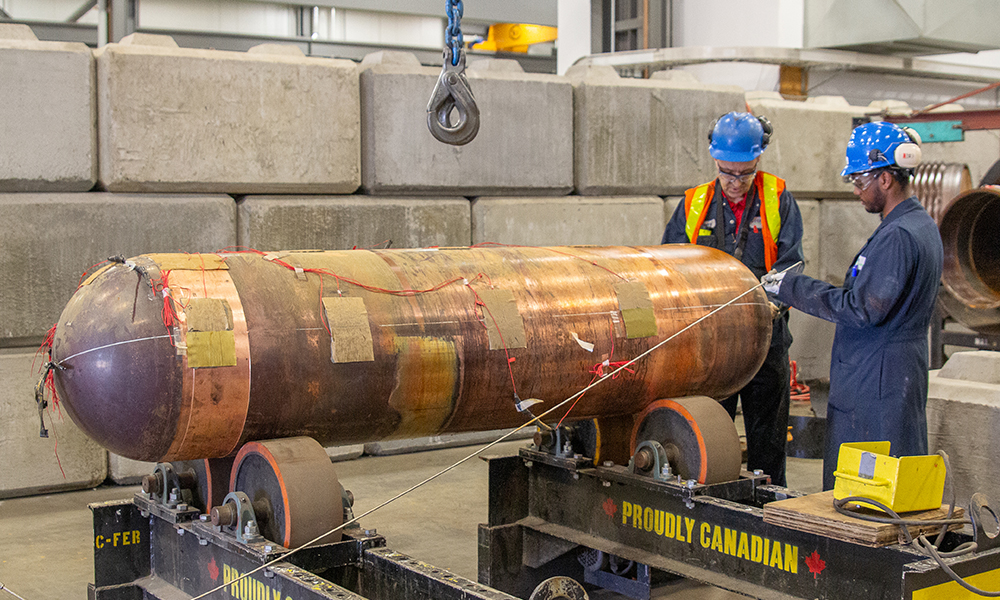Engineering, safety and technical research
Engineering
Advancing the design of the deep geological repository and continuing to develop the project’s safety assessments were key engineering program priorities throughout 2023.
Among our achievements this year were progressing the repository design and the conceptual design of the Used Fuel Packaging Plant, and completing the final pressure tests of the Used Fuel Containers. This work built on the successful proof test completed in 2022: a series of demonstrations to ensure that elements of the multiple-barrier system design are performing as expected.
Progress on repository design this year included the design of surface site layouts and infrastructure, the layout of the underground facilities and panels in which the Used Fuel Containers will be stored, as well as the systems to support the repository.
The Used Fuel Packaging Plant conceptual design includes the layout of the plant, the development of the plant processes and systems, and a study on the operational handling of the Used Fuel Container.
Pressure tests on the Used Fuel Containers were part of the proof test program that began in 2014 and culminated in the successful test in 2022. The final pressure tests of the Used Fuel Containers were completed in 2023 and were successful. They showed that the containers easily handle even conservative estimates for the maximum pressure that may develop within the underground repository. After successive pressure cycles that would correspond to many glaciation events, the containers are mechanically unchanged.
In fact, even when extreme pressures far exceeding realistic conditions are applied to a container, it still remains leak-tight, meaning that the used nuclear fuel will be contained safely for beyond-design events. This test validated our design analysis and computer simulation models, further enhancing our confidence that the design is safe.
We exposed Used Fuel Containers to pressures above any realistic scenario to demonstrate they will remain leak-tight.
Safety and technical research
In 2023, we continued to develop the safety case for the repository project, which involves gathering evidence to show the project is safe from a technical and social perspective, and advancing the preliminary site-specific safety analyses for both potential repository sites.
Our analysis of long-term safety this year looked at the potential consequences on people and the environment if the multiple-barrier system, specifically the Used Fuel Containers, were to fail. We considered various unlikely scenarios, assuming several to all containers failing because of unexpected conditions in the repository (for example, unexpected groundwater chemistry or microbial activity) or due to extreme glaciation. Our analysis considered a future person with an “imaginary maximum” lifestyle, an entirely theoretical lifestyle designed to receive maximum potential exposure. For example, this person is assumed to live above the repository and only drink water from a deep well located wherever there is the greatest dose potential. We also considered several local lifestyles in both areas, including rural residents, town residents and residents who live off the land. In all scenarios considered this year, the estimated impacts from the repository at either site were well below the natural background and the regulatory dose limits. Our safety analyses continue to demonstrate that the project would be safe at either site.
Additional studies this year also reinforced our confidence that the rock formations in either area can support the deep geological repository for the very long term, regardless of extreme scenarios.
Earthquakes are one of several factors to be examined in the repository site evaluation process. Both potential siting areas are known to have low seismic activity. Neither site has shown seismic activity that would make the site unsafe.
In 2023, we advanced work on understanding future seismic activity focused on northern Ontario. This involved working closely with Natural Resources Canada to build baseline calculations and methodologies that can predict long-term seismic activity within a crystalline shield environment, which applies to the rock at the Revell Site in the Wabigoon Lake Ojibway Nation (WLON)-Ignace area. These are based on a multidisciplinary approach that looks to estimate the strength, frequency, effects and location of historic earthquakes. We also installed a microseismic monitoring network (nine stations in the WLON-Ignace area and five stations in the Saugeen Ojibway Nation-South Bruce area) within a 50-kilometre radius of our sites for the purpose of detecting small earthquakes.
A microseismic station gathers information to further understand the potential for earthquake activity in one of our potential siting communities.
A project started at the end of 2023 is the seismic hazard assessment. This project will take the data we have been collecting from the regional seismic monitoring and from the microseismic stations in our potential siting communities and help us develop tools to assist in predicting the magnitude and frequency of future seismic events around the repository for the next 1 million years. Results of the work will be available in late 2026. Seismic studies will continue and be updated throughout the operation of the repository and beyond.
A testament to these efforts — and all the work undertaken in the area of seismic activity over the past decade — is an article published in PAGES Magazine in late 2023 that summarizes the collaborative work undertaken by the NWMO and Natural Resources Canada in northern Ontario. A journal paper on the study will also be submitted in 2024.
In total, we supported 31 journal papers and six technical reports in 2023, reinforcing our leadership in safety, engineering, and scientific and technical research. We also continued to demonstrate international collaboration and leadership as we developed peer-reviewed data and publications that will contribute to both the engineering design and safety assessments of the repository.
We’re proud to continue collaborating closely with academia, government and international organizations as we advance Canada’s plan for used nuclear fuel. Our work together in 2023 continued to reinforce our commitment to safety and our confidence that a deep geological repository in either potential siting area can be constructed and operated safely.


